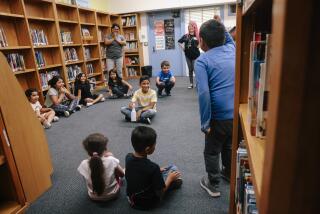Santa Paula : Library Cuts Imperil Literacy Programs
Two Santa Paula literacy programs that serve 65 individuals and 40 families may find themselves out on the streets because of budget cuts at the library where the sessions are held.
Blanchard Library will have to trim its hours by 40% after voters in November rejected a $5-per-property tax, said Elaine Hunt, who coordinates the literacy programs. Beginning Jan. 14, the library will be open only three days a week instead of five.
There is not enough room for the classes to take place during the time the library will be open to the public, and the facility cannot afford to heat and light the building after hours, Hunt said.
Hunt has been offered temporary use of Santa Paula’s community center for the 5-year-old Family Literacy: Aid in Reading program, which twice a week pairs 65 adult students with trained volunteer tutors. However, the state grants that provide funding for the FLAIR program specify that it must be a library-related activity.
“The programs lose their identity as library services if they go elsewhere. I can’t write new proposals without stable circumstances,” Hunt said.
In the other program, the 2-year-old Families for Literacy, 40 families meet once a week. The parents, who learned to read through FLAIR, discuss how to read to their children and talk about such issues as how to encourage their children to stay in school and how to feed them nutritiously. Children attend with their parents and receive free books.
Hunt estimates it would cost about $2,000 to light and heat the library for the after-hour programs, which would be in session six hours a week through June 30. She has obtained permission to use some of the state grant money to pay for these utilities so the FFL program can continue to meet on Saturdays, but Hunt and Jeri Mead, administrator of Families for Literacy, are looking for a smaller facility so it will not cost as much to run.
“I am in a state of trying to figure out what to do now. It would break my heart not to continue these programs; they are so successful. We have had 400 people go through FLAIR, most of whom have graduated. Some go on to higher education and get their GED (a high school equivalency diploma). One mother of 10, who learned to read through FLAIR, is even working on her college degree,” Hunt said.
“It is such a cost-effective program. These people have made a commitment to improve the quality of their lives. They are not asking for a handout,” Mead said.
It costs about $32,000 a year to run the programs, Hunt said.
More to Read
Sign up for Essential California
The most important California stories and recommendations in your inbox every morning.
You may occasionally receive promotional content from the Los Angeles Times.










